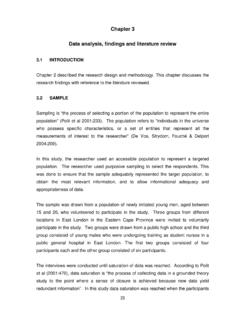Transcription of Key Performance Indicators, Six Sigma, and Data …
1 WHITEPAPER Key Performance Indicators, Six sigma , and Data Mining Data Driven Decision Making for Financial Institutions 2 Table of Contents Executive Summary .. 4 Key Performance Indicators: Frameworks for Action .. 6 Productivity Improvement Drives Wealth Creation .. 6 Metrics Matter .. 6 What Gets Measured Gets Done .. 8 Creating Relevant Metrics .. 9 Creating KPIs and Tracking Performance Against Them .. 9 KPIs As Opportunity Areas ; Six sigma Fit .. 10 Six sigma Overview .. 11 Six sigma Business Value Benefits and Methodology.
2 11 The Expanding Orbit of Six sigma Related To KPIs .. 13 DMAIC in the Expanding Six sigma Environment .. 16 Putting Business Processes Under The Six sigma Microscope .. 17 Illustrative Business Processes Affected By Six sigma (By Function) .. 17 Illustrative Business Processes Affected By Six sigma (By Industry) .. 19 Integrating KPIs and Six sigma .. 19 Needs for Measurement Tools; Data Mining Fit .. 20 KPIs, Six sigma and Data Mining: Process Optimization to The Power of Three .. 20 Data Mining Overview .. 20 The Data Mining Process.
3 21 Using Data Mining Insight To Improve Corporate Performance .. 22 Data Mining Connections with KPI and 6 sigma Based Management Systems .. 24 Leveraging Six sigma and Data Mining Skill Sets .. 25 Domain Knowledge .. 25 Project Management .. 25 Analysis Skills .. 25 IT and Data Competencies .. 26 Leveraging Enterprise Systems .. 26 Typical Corporate 26 G2500 Organization Environments .. 28 3 Financial Services Organizations: Applying KPI, 6 sigma and Data Mining Principles to Boost Productivity .. 29 Getting Specific On KPI Selection.
4 29 Applying the Six sigma Treatment To KPIs To Eliminate Defects .. 30 Using Data Mining to Accelerate Analysis and Results .. 31 Conclusion .. 32 4 Executive Summary Productivity gains through continuous process improvement can contribute to profitability by supporting both revenue growth and cost reduction. In this context, leading organizations increasingly emphasize continuous process improvement through data driven decision-making to achieve these benefits. This white paper focuses on three specific management systems at the core of process optimization initiatives, each with their own jargon, methodologies and tools: Key Performance Indicators (KPIs) with its emphasis on establishing and communicating targets for operating Performance and benchmarking actual Performance against Six sigma with its emphasis on identification of opportunities for eliminating defects as a means of achieving continuous improvement in core business processes2.
5 Data Mining with its emphasis on learning from the past and predicting future Performance with higher confidence through continuous analysis of operational data from diverse KPIs, Six sigma , and Data Mining management systems, methodologies and tools are closely related. An understanding of these relationships can help organizations accelerate productivity gains in their operations and thereby improve profitability. This white paper summarizes these relationships and illustrates how these business value benefits are achieved.
6 It provides a framework for discussion about (i) how KPIs are made relevant and actionable within organizations; (ii) how 6 sigma process optimization initiatives linked to KPIs are broadening to enable improved data driven decision-making well outside their traditional quality assurance boundaries; and (iii) how data mining processes support the variability in experience between Performance achievements and target Performance goals (from a KPI standpoint) and enable organizations to maximize opportunities for defect reduction (in 6 sigma language).
7 This white paper illustrates how data mining is both logically and practically connected with KPI and Six sigma based management systems and outlines a more systemic approach organizations can use to 1 Key Performance Indicators or Balanced Scorecards incorporating both financial and non-financial measurement categories to achieve operational and strategic goals are a common top down management objective. These systems are typically based on Identifying financial, business process, customer satisfaction and internal development metrics that support corporate goals, selecting lagging (outcome) and leading ( Performance driver) measures that drive operational Performance and achievement of these results, and establishing systems and procedures to track variations in Performance and adjust Performance metrics.
8 2 Six sigma has been traditionally used primarily in manufacturing industries, and with an orientation towards product defects, quality improvement and production optimization. Many organizations across numerous industry verticals have embraced these principles with their systemic emphasis on Define, Measure, Analyze, Improve, and Control . 3 Data mining involves the use of methodology and software tools to analyze data assets to identify patterns, causal relationships and anomalies that impact on business Performance (to reduce fraud, reduce product defects, tighten credit rules etc) and to make this knowledge actionable within the enterprise to improve business rules that drive revenue growth, cost containment and risk reduction through model deployment in the form of reports , scores etc.
9 5 apply KPIs, Six sigma principles and data mining tools in the context of process optimization initiatives. Key Performance Indicators define opportunity areas or focus areas for process improvements. Six sigma initiatives incorporate a rigorous DMAIC based methodology of experimentation, analysis and assessment to reduce variability between target and actual Performance outcomes. Data mining provides robust, efficient analytical tools and techniques that can be used to identify drivers of both success and failure in eliminating variability from expected Performance .
10 The schematic below (Figure 1) summarizes the business process relationships between senior management (executives), line of business | business unit management (managers), and personnel (analysts and business teams) through which this integrated, systemic approach is implemented. This approach enables productivity gains through continuous evaluation of actual versus expected Performance of KPI based metrics and continuous root cause analysis of variability in results and their causes applying Six sigma principles and data mining tools.





